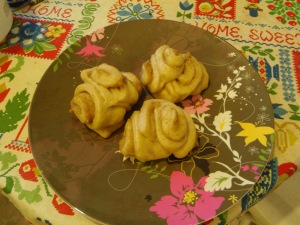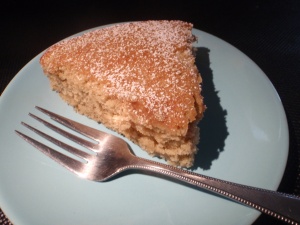
King Arthur unbleached cake flour blend
LET ME EAT CAKE!!!
My favorite dessert is cake. Light and fluffy, meltingly moist or hearty with produce and nuts, frosted or not, cake calls to me. And I answer “Yes!” every time—as long as it’s honest. For me, honest ingredients don’t include artificial flavors and preservatives, hydrogenated fats or GMO ingredients. I bake a scratch cake at least once a week so when I noticed some months ago that I’d run out of cake flour (always chemically bleached), I decided to work with alternative flours. Bleached cake flour will almost always yield the softest, fluffiest and most tender crumb in a cake. As I enjoy the full flavor and toothsome texture whole grains can deliver in baked goods, I consider my adapted recipes to be superior, even if somewhat coarser (although if a cake comes out too coarse, or otherwise texturally faulty, that’s not a success.)
Now King Arthur Flour has come out with an unbleached cake flour product (not organic, though). A blend of soft wheat flour, malted barley flour and unmodified cornstarch, King Arthur promises “medium-fine” textured results. I bought the two-pound box at Whole Foods for $4.99. I’ve made two different cakes with this flour, and both turned out with a quite acceptable crumb. If I hadn’t mentioned the flour to any of the lucky tasters, no one would have suspected a thing.
For my first experiment, I chose the Heavenly Coconut Seduction cake (coconut milk version) from Rose Levy Beranbaum‘s new Rose’s Heavenly Cakes book. A gorgeous work, almost every cake is illustrated in full color on a full page. For the cake baker, this treatise delivers an education in cake composition, construction and craft. I highly recommend it!
With the King Arthur unbleached cake flour blend, the coconut cake baked up a little denser and slightly more resilient, less yielding. Still, for any dessert lover confronted with this moist flavorful layer (sans topping…I’m not Supermom!), the texture was much better than acceptable. Beranbaum notes that the original version, which calls for cream of coconut (CocoLopez, which I don’t use) MUST be made with bleached cake flour or the structure will dip dramatically in the center. She knows cake chemistry, so, trusting her judgment, I tackled the recipe with Whole Foods 365 organic coconut milk (not light!). A winner!
I baked another coconut cake with KA’s cake flour blend, this time using the creaming method (Beranbaum’s cake, like most of her butter cakes, utilizes the two-stage mixing method). Fantastic! Moist and tender, this flavorful layer exhibited no textural shortcomings. I tried not to eat the whole thing.
So far (that is, two cakes into it), I can recommend King Arthur’s cake flour blend. I haven’t tried it in sponge cakes, yet. I expect good results, though, and of course I’ll keep you posted. I can’t wait ’til King Arthur comes out with the organic version!
COCONUT CAKE makes one 9″ layer
- 4 ounces (1 stick) butter, softened. I like Organic Valley. Click for a $1 OFF coupon. Beranbaum recommends this brand as well, and she’s not even biased towards organics.
- 2/3 cup organic coconut milk (not light), well-shaken and close to room temperature. Whole Foods 365 is great and a great buy.
- ¾ teaspoon vanilla extract
- 1/2 teaspoon natural coconut extract or ¼ almond extract (optional)
- 2 local eggs, close to room temperature, lightly beaten.
- 200 grams (1 cup) organic sugar. You can find this in bulk departments at our natural grocers and Central Market packages their own brand for $2.99 for a 2 pound bag.
- 167 grams sifted King Arthur Flour cake flour blend. That’s about 1 ¼ cups plus 1 Tablespoon (sift into your measuring vessels).
- 1 teaspoon plus a heaping ¼ teaspoon baking powder, sieved. I use Rumford non-aluminum baking powder.
- heaping 1/8 teaspoon salt
Get your oven heatin’ to 350º. Grease up and flour a 9″ round cake pan (at least 2″ tall). I mixed up some “pan prep” recently, combining coconut oil (you can also use ghee) and all-purpose flour until I got a spreadable paste that I can brush onto cake pans. It’s very handy and works well, and eliminates a can of baking spray. I like to put a baking strip around the pan to help the cake cook evenly. For a cute DIY tutorial on baking strips check out littleladycakes.com on Youtube.
Using a stand mixer (my preference) or a hand mixer, gradually cream the sugar into the butter until light and fluffy. Scrape down the sides and bottom of the bowl with a flexible spatula a couple of times to ensure that the mixture is evenly incorporated. Gradually beat in the eggs, scraping the bowl as necessary. Beat for another minute to achieve a very light, fluffy homogeneous mix.
Combine the coconut milk and extracts. Beat the dry ingredients into the batter in three parts alternately with the coconut milk, beginning and ending with the flour mixture. Scrape the bowl with your spatula after each addition to ensure the ingredients are well-incorporated. Pour the batter into your prepared pan (if you’re not using baking strips, the cake bakes more evenly if you mound the batter up around the sides a bit) and bake for about 36 minutes, until the cake tests done (a bamboo skewer inserted into the center will come out clean.)
I usually don’t have time for frosting these days. We didn’t miss it. But anything from milk chocolate ganache, whoop cream, coconut or vanilla buttercream, or even a simple coconut milk glaze could guild this lily. Now you can leave out the bleach!









